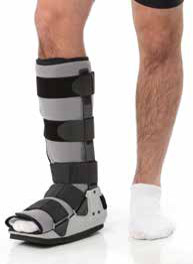
Healing a Broken Fibula: Stay Active with a Walking Boot
A broken fibula may be very painful, but sitting on the couch and letting it heal on its own is probably not the best approach.
While your fibula—the long, thin outside bone of your lower leg—is healing, you should stay mobile with a walking boot.
What is the Fibula?
The fibula is one of the two bones in your lower leg.
It runs parallel to the tibia, but unlike the tibia, which bears most of your weight, the fibula is primarily responsible for supporting muscles rather than supporting the body’s weight directly.
Though it is often less stressed than the tibia, it plays an important role in stabilizing the ankle and lower leg.
– The Benefits of Using a Walking Boot
Although the fibula is considered a weight-bearing bone, it bears only 17% of your total body weight when upright.
Because the burden on the bone is minimal—compared with the burden on the tibia or femur—using a walking boot often shortens recovery time.
How the Walking Boot Works:
- The boot immobilizes the leg and protects the bone, but it does not restrict movement of the surrounding muscle tissue.
- The walking motion reduces muscle atrophy, which in the end makes physical therapy more effective.
- Without atrophy, strengthening exercises can start sooner, leading to a faster and more complete recovery.
– Types of Fibula Fractures
This theory applies to all types of fractures:
- Nondisplaced: The bone retains its proper alignment.
- Displaced: The bone ends do not line up.
- Compound: The bone breaks through the skin.
Regardless of the type of fracture, the use of a walking boot can facilitate more efficient healing.
It does this by promoting muscle activation and preventing the stiffness and weakness that can occur when the leg is kept immobile for extended periods.
Recovery Time Varies
The length of recovery is not the same for everyone.
Although the boot speeds up general recovery time, recovery times fluctuate depending on the severity of the break and the patient’s commitment to physical therapy.
– Factors Influencing Recovery:
- Severity of the Fracture: A minor, nondisplaced fracture may heal relatively quickly, while a more serious break may require a longer period of immobilization.
- Patient Commitment: Recovery is often faster for those who follow their physical therapy program diligently.
What to Expect During Physical Therapy
It is important to remember that when physical therapy begins, there is a strong possibility of muscle pain and fatigue.
Don’t worry—this is normal.
Remember, you are rehabilitating the muscles around a bone that suffered a traumatic injury. Your muscles will have been somewhat weakened by the immobilization, even if you used a walking boot, so some initial discomfort is to be expected.
Benefits of a Well-Structured Therapy Program
A good physical therapy program focuses on gradually rebuilding muscle strength and flexibility while ensuring that the healing bone is not stressed too early.
By following this program, you reduce the risk of re-injury, improve the healing process, and ultimately recover faster.
– Moving Forward After Injury
If you are faced with a broken fibula, don’t panic. Talk to your physician about the walking boot option.
As your healing progresses, we will work with you and your physician to design a program to increase your strength and range of motion and improve flexibility.
Our goal will be to build strength and endurance so you can resume your everyday activities.
– Commitment is Key to Recovery
Commitment to the physical therapy plan is key to effective healing.
Physical therapy is most effective when you stick to the schedule and assigned exercises and continue to care for the injury while at home.
Regain Your Life
We understand that you have more important things to do than sit around healing.
A well-executed recovery plan, starting with the use of a walking boot, will help you get back to your normal life faster— after all, we know you have more important things to do than have people sign a cast!
Take control of your recovery—contact us today and let’s work together to get you back on your feet.
Did you know you have Direct Access* to Physical Therapy? No referral, no problem!

















